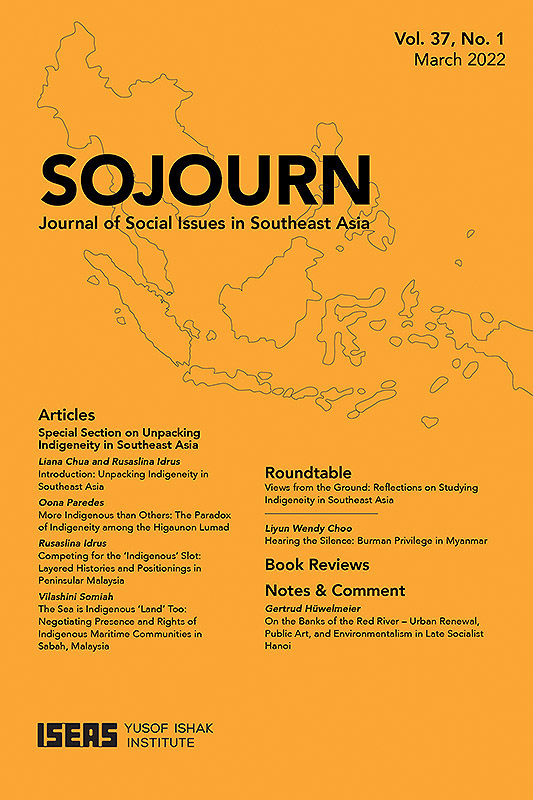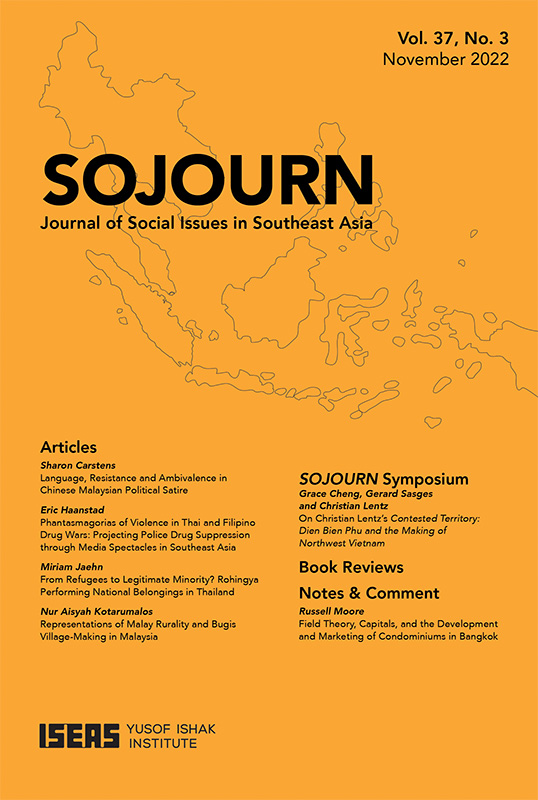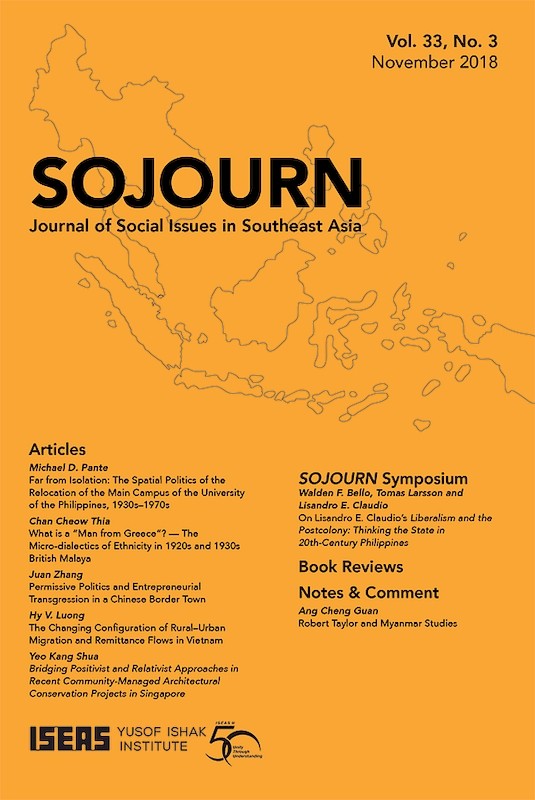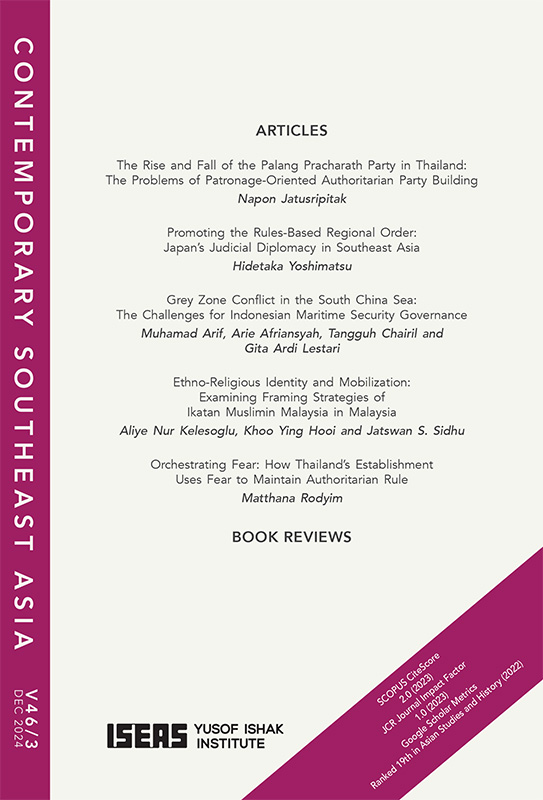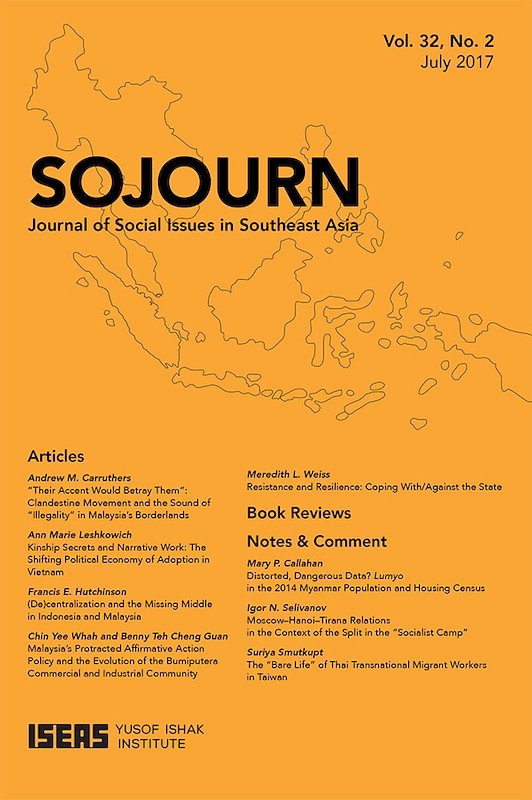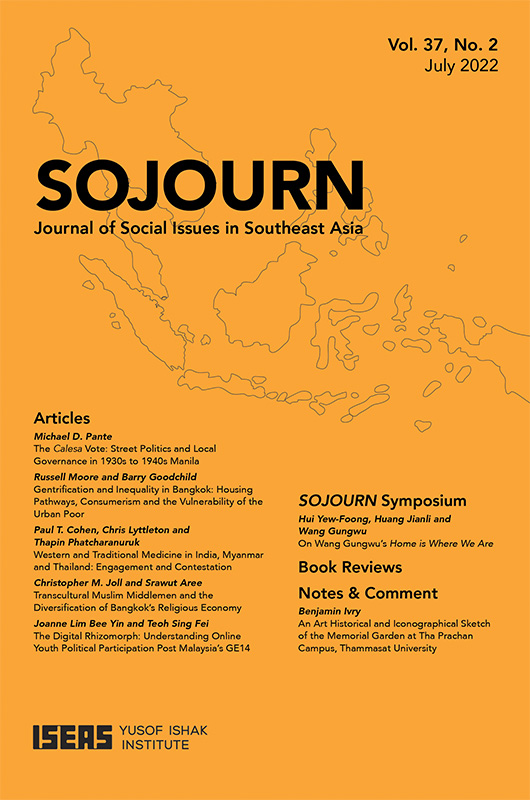SOJOURN: Journal of Social Issues in Southeast Asia Vol. 39/1 (March 2024)
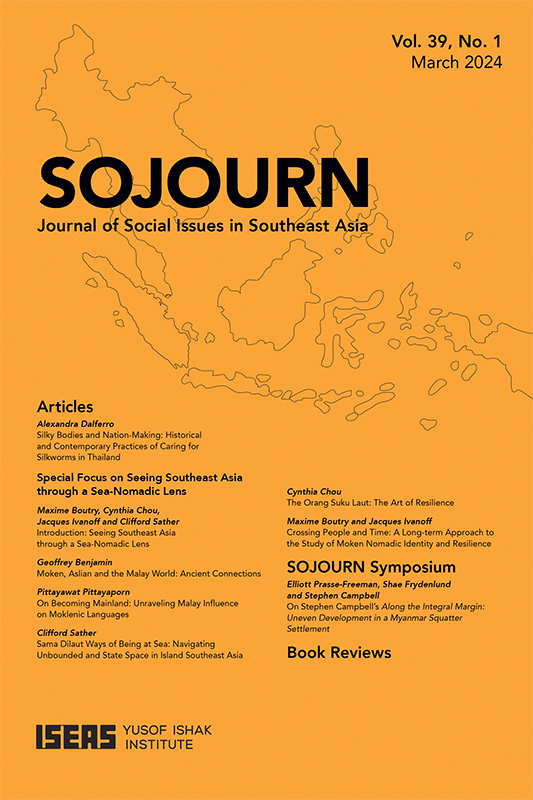
Date of publication:
March 2024
Publisher:
ISEAS – Yusof Ishak Institute
Number of pages:
225
Code:
SJ39/1
Soft Cover
ISSN: 02179520
Contents
-
SOJOURN: Journal of Social Issues in Southeast Asia Vol. 39/1 (March 2024)
[Whole Publication, ISSN: 17932858] -
Preliminary pages
- ARTICLES
-
Silky Bodies and Nation-Making: Historical and Contemporary Practices of Caring for Silkworms in Thailand, by Alexandra Dalferro, author see abstractThis article explores practices of raising domesticated silkworms and the embodied ethics that inform these ways of caring in northeast Thailand. Combining ethnography and historical analysis, I consider how both silkworms and the humans who raise and then kill them have experienced forms of “rough care” through state-organized encompassment and resettlement onto silk farms in the mid-twentieth century. Rough practices of care continue to the present day, with implications for how human and non-human beings live together amid increasing precarity.
- SPECIAL FOCUS ON SEEING SOUTHEAST ASIA THROUGH A SEA-NOMADIC LENS
-
Introduction: Seeing Southeast Asia through a Sea-Nomadic Lens, by Maxime Boutry, Cynthia Chou, Jacques Ivanoff, Clifford Sather, authors
-
Moken, Aslian and the Malay World: Ancient Connections, by Geoffrey Benjamin, author see abstractMoklenic (Moken plus Moklen) is now thought to constitute a top-level division within the Malayo-Polynesian subfamily of Austronesian. Its ancestral language must therefore have been established in the region by 3,500 years ago, at least 1,000 years before the arrival there of the Malayo-Chamic languages. Consequently, ancestral Moken is likely to have been spoken more widely in the past than its current narrow distribution along the west coast of southern Myanmar and Thailand. The presence of lexical loans in Moken from other languages—Chamic (along with Acehnese), Malay, Austroasiatic (including Aslian, Mon, Khmer and Nicobarese), as well as Thai and Burmese—indicates that its speakers have long interacted with other regional populations, possibly on both sides of the Kra Isthmus. In turn, Moken has left lexical traces in several other Southeast Asian languages, indicating that its speakers played a bigger role in the region around 2,000 years ago than they have done in more recent times.
-
On Becoming Mainland: Unraveling Malay Influence on Moklenic Languages, by Pittayawat Pittayaporn, author see abstractThis study examines the impact of Malay on Moklenic dialects spoken by Moklen and Moken communities to uncover the historical contact setting between Proto-Moklenic and Malay. It shows that a significant portion of Proto-Moklenic vocabulary was borrowed from Malay, while aspiration and three-way vowel height contrasts arose from Malay influence. Sociolinguistic dynamics resulting from contact between Moklenic and Malay, as reflected in the contact-induced changes, indicate a long-lasting and closely intertwined, though asymmetrical, relationship, which suggests widespread bilingualism and openness towards the influence of Malay.
-
Sama Dilaut Ways of Being at Sea: Navigating Unbounded and State Space in Island Southeast Asia, by Clifford Sather, author see abstractThis article explores what it means to exist in the world as self-described “sea people”. Coming and going was formerly a constant feature of everyday life; specific places functioned more as navigational bearings than as settlement sites or sources of collective identity, and communities were defined by social networks and trajectories of travel. The Sama Dilaut world was one of “stasis in motion” in which individuals located themselves by directional coordinates and seasonal cycles in constant rotation. Sama Dilaut origins are related to the formation of maritime trading states whose wealth derived largely from outside “state space” and from relations with mobile groups like the Sama Dilaut community described here whose movements subverted the boundaries between “state” and “non-state space”.
-
The Orang Suku Laut: The Art of Resilience, by Cynthia Chou, author see abstractThe Orang Suku Laut in the Riau Archipelago, who are under Indonesian jurisdiction presently, were once highly esteemed for their nomadic lifestyle, which helped open new areas to generate wealth for sedentary populations; today they are held in disdain by policymakers, who apply pressure through the state apparatus to change their lifestyle. Some Orang Suku Laut remain fully nomadic, others have resorted to limited seasonal residence on their boats and yet others have chosen or been forced to be completely sedentarized in coastal settlements. Although they have not been able to ward off state control completely, their continued widespread presence in Southeast Asia bears testament to their resilience in maintaining their cultural identity. This article discusses the strategies developed by the Orang Suku Laut to maintain their identity and assesses their capacity for resilience.
-
Crossing People and Time: A Long-term Approach to the Study of Moken Nomadic Identity and Resilience, by Maxime Boutry, Jacques Ivanoff, authors see abstractThe Moken are a sea-nomadic population living in the Mergui Archipelago, where they remained out of the reach of the state while developing clientelist relationships with dominant societies over several centuries. Starting in the mid-twentieth century, economic development and Burmese colonization of the islands led the Moken to face major transformations of their territory and way of life. This article takes a long-term approach to understanding Moken resilience by examining their oral literature, rituals and mobility developed in connection to the populations they live alongside. It shows that the Moken have maintained a core nomadic identity that enabled them to develop clientelist relationships throughout successive historical eras.
- SOJOURN SYMPOSIUM
-
On Along the Integral Margin: Uneven Development in a Myanmar Squatter Settlement by Stephen Campbell, by Elliott Prasse-Freeman, Shae Frydenlund, Stephen Campbell, authors
- BOOK REVIEWS
-
BOOK REVIEW: Intercultural Exchange in Southeast Asia: History and Society in the Early Modern World, edited by Tara Alberts and D.R.M. Irving, by Scott C. Abel, author
-
BOOK REVIEW: Spirit Possession in Buddhist Southeast Asia: Worlds Ever More Enchanted, edited by Bénédicte Brac de la Perrière and Peter A. Jackson, by Edoardo Siani, author
-
BOOK REVIEW: Burmese Haze: US Policy and Myanmar’s Opening—and Closing by Erin Murphy, by Jürgen Haacke, author
-
BOOK REVIEW: The Phantom World of Digul: Policing as Politics in Colonial Indonesia, 1926–1941 by Takashi Shiraishi, by Joshua Barker, author
-
BOOK REVIEW: Irregular Migrants and the Sea at the Borders of Sabah, Malaysia by Vilashini Somiah, by Andrew M. Carruthers, author
-
BOOK REVIEW: Whose Islam? The Western University and Modern Islamic Thought in Malaysia,by Megan Brankley Abbas, by Ronald Lukens-Bull, author
-
BOOK REVIEW: Wang Gungwu and Malaysia by Danny Tze and Ken Lee Kam Hing, by Ho Chi Tim, author
-
BOOK REVIEW: Inside the Philippine Revolution: The New People’s Army and Its Struggle for Power by William Chapman, by Joseph Scalice, author
-
BOOK REVIEW: Slum Imaginaries and Spatial Justice in Philippine Cinema by Katrina Macapagal, by Rolando B. Tolentino , author
-
BOOK REVIEW: Silence and Sacrifice: Family Stories of Care and the Limits of Love in Vietnam by Merav Shohet, by Christian C. Lentz, author

